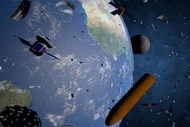Create a free profile to get unlimited access to exclusive videos, sweepstakes, and more!
What do movies get wrong about the International Space Station?

This week marks an important anniversary for the International Space Station. The first module of the ISS was launched in 1998, but there weren't always crewmembers living up inside until Nov. 2, 2000. Since that time — 20 years ago this week — this international collaborative effort has sustained an unbroken human presence off of the planet. For two decades, there have always been humans in space.
There’s something almost overwhelming about the humble nature of it all, the way it’s become such an ordinary part of our lives. Most of us move from day to day without even considering that there are people living in space, and that we have had humans in the ISS, every single day, for the last 20 years.
The International Space Station has become such a part of our lives that it’s fully crossed over from the realm of pure science, to being part of our culture. Astronauts tweet from space, they take interviews and talk to students. A few years back, Chris Hadfield, then commander of ISS, became something of an online celebrity owing to the way he communicated life in space. He made a viral music video where he covered David Bowie’s "Space Oddity," and his photography from out the porthole window has since been bound into a coffee table book.
Recently, there have been talks of Tom Cruise filming a movie on the station, and in the meantime, the ISS has become a regular set-piece in science fiction films and television. An endeavor so impressive and inspiring as an international effort to house humans in space, deserves every bit of public spotlight it has garnered. It’s good that our only permanent home off Earth has so captured the public imagination. With that, however, comes inaccuracies. Imagined scenarios that fly a little too far afield. Here’s what Hollywood has gotten right, and what Hollywood has gotten wrong, about space stations.
ARMAGEDDON’S SPECTACULAR EXPLOSION OF MIRMIR was the predecessor to the ISS, in operation from 1986 to 2001, and under control of the Soviet Union — later Russia. MIR was the first modular space station and held the record for the largest human spacecraft and longest continuously crewed spacecraft until superseded on both accounts by the ISS. But, when the 1998 disaster movie Armageddon was being made, the ISS hadn't been launched yet. So, Bruce Willis and his crew made a pitstop on MIR to disastrous results.
Look — there’s plenty about Armageddon's "science" to nitpick. The central premise of objects being pushed out of the asteroid belt by a rogue comet strains credulity. The asteroid belt doesn’t look the way it’s often portrayed in films, with objects packed closely together, clanging off one another. As you might expect, Armageddon gets some important details wrong when it comes to space stations.
In one of the early action scenes of the film, our heroes dock with MIR for a fuel transfer when a fire breaks out, inevitably resulting in the catastrophic destruction of the station. It makes for good viewing (or at least it did in 1998) but there are some problems here.
Fire prevention in space is taken pretty seriously, especially after the events of Apollo 1, which ended with the tragic loss of the crew, here on the ground. The first big flaw in the way Armageddon presents this disaster is in the visage of the fire itself. Flames don’t behave in space the same way they do on Earth. Instead of flickering tendrils, fire in zero gravity creates relatively small spheres.
The crew aboard the ISS also have a lot more control over their environment than we do here at home. Were a fire to break out aboard the station, the crew could cut power to a module and turn off air circulation, removing a source of heat and reducing oxygen. Most fires would have their feet cut out from under them then and there. There’s also the fact that most materials in space (with few exceptions) are designed specifically to be non-flammable.
It’s unlikely that an unplanned event would cause the space station to go up in flames, but whatever happens, it will end in fire. When the station reaches the end of its life, it will de-orbit, plunge into the atmosphere, and burn up.
SPINNING SPACE STATIONS
It’s a common vision — an entire station, or part of it, spinning in order to reproduce the pull of gravity, so sorely missed in space. Famously portrayed in Stanley Kubrick’s 2001: A Space Odyssey, the idea is that a spinning station would recreate the feeling of gravity through centrifugal or centripetal force, depending on your frame of reference.
It’s a pretty well-known phenomenon, one which is a fairly common experience in real life. In short, when a system rotates, centripetal force acts upon that system to keep it moving along a circular path rather than being flung outward from the center. From the outside, that is measured as an inward force acting upon the system, pressing toward the center. But if you’re inside the system, like an astronaut or cosmonaut aboard a space station, you would experience it as a pressing outward.
This is really the same force, just experienced from disparate frames of reference. As the system presses in on you, you press out on it, and you have a sense of gravity. This sort of space station isn’t wholly unrealistic. It’s a moderately good place holder for actual gravity, but there's no spinning or simulated gravity to be found on the ISS, and for a good reason.
The International Space Station is intended to be a microgravity laboratory. One of its main purposes is to understand the impact of low gravity on objects, processes, and people. To that end, spinning the station to create an artificial feeling of gravity is at odds with its intent, but it might make sense for long-term, missions in the future.
DEADLY COLLISIONS AND CLOSE QUARTERS
In the 2013 film, Gravity, directed by Alfonso Cuaron, we’re presented with a seemingly more realistic space-disaster scenario. Ground-based mission control alerts astronaut Dr. Ryan Stone (Sandra Bullock) of an incoming cloud of debris threatening the safety of the mission to repair the Hubble Space Telescope. Subsequently, the space shuttle Explorer (the shuttle program was decommissioned in 2011 but is still operating in Gravity's fiction) was damaged and the only hope of returning to Earth was a risky trip to the International Space Station by way of the Manned Maneuvering Unit (MMU).
The film portrays the trip from Hubble to the ISS as being roughly 900 miles. No real problem there, at least in the numbers. The ISS orbits about 250 miles above Earth’s surface, while Hubble resides 90 miles higher. Given their respective orbits and inclinations, it’s unlikely that the two find themselves very near one another, so that right there makes Dr. Stone's journey unlikely. It becomes impossible when you consider that she's attempting to make the trip using her Manned Maneuvering Unit. The MMU is designed for brief trips within sight of your craft. They are not intended for road trips through space.
An MMU is equipped with two tanks, each with 5.9 kg of nitrogen for use in propulsion. They are capable of moving at about 80 feet per second. At that speed, a 900-mile trip would take more than 16 hours, and that’s if you could move in a straight line. According to NASA, the available oxygen and carbon dioxide removal systems present in EVA suits are suitable for spacewalks between 6 to 8.5 hours, only half the duration of a 900 mile trip at 80 feet per second. Getting to the ISS just isn't that easy.
Still, even without the gloss of Hollywood movie magic, the International Space Station is objectively one of the coolest endeavors we’ve ever embarked upon as a species. We’re glad to celebrate 20 years of exploration with it, and we hope humans keep a presence in space for another two decades. Who knows, maybe Tom Cruise will be one of those humans aboard the ISS some day.














